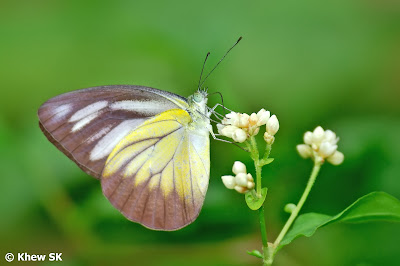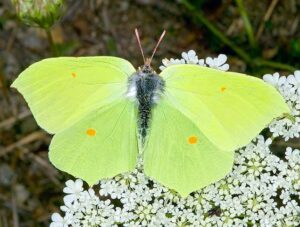
Chocolate Albatross butterfly
The chocolate albatross has a wingspan of 55 to 70 mm. The male is white above with chocolate-brown or black margins, and, bright lemon yellow below with chocolate-coloured markings. The female is white and densely clouded with dark brown.
Did you know?
The chocolate albatross is a forest butterfly and prefers rainy highlands, up to a level of 3,000 feet (910 m).
Habits
The chocolate albatross is a forest butterfly and prefers rainy highlands, up to a level of 3,000 feet (910 m). Flying strongly and swiftly close to the ground, the albatross is frequently found in jungle clearings and along stream banks. The males are often found circling around trees and bushes. The chocolate albatross often mudpuddles, sometimes in large numbers. The butterfly occasionally visits flowers and has been recorded to visit Verbena flowers in Kodagu.
Life cycle
The larvae have been recorded on Crataeva religiosa, Capparis roxburghii and Capparis heyneana.
Life History of the Chocolate Albatross (Appias lyncida vasava)
Butterfly Biodata:
Genus: Appias Hübner, 1819
Species: lyncida Cramer, 1777
Subspecies: vasava Fruhstorfer, 1910
Wingspan of Adult Butterfly: 45-55mm
Caterpillar Local Host Plants: Crateva religiosa (Capparaceae, common name: Sacred Garlic Pear), Crateva magna (Capparaceae, common name: Large Garlic Pear).
Physical Description of Adult Butterfly:
On the upperside, the male is mostly white with a dentate dark brown border on both forewing and hindwing; the female is dark brown with several whitish distal streaks in both the forewing and hindwing. On the underside, the male is lemon-yellow with broad dark brown border in the hindwing and dark brown with white distal streaks and yellow apical spots in the forewing; the female is white yellow-dusted with a broad brown border in the hindwing and brown with white distal streaks in the forewing.




Field Observations of Butterfly Behaviour:
The Chocolate Albatross is considered a seasonal migrant in Singapore. The adult butterflies are usually sighted more frequently during certain times of the year flying in both nature reserves and urban parks across Singapore. Typically in each sighting only one single individual is observed. It is believed that they fly from southern Malaysia where they occur in abundance during the April to June period. The scarcity of their host plants (in Capparaceae) in Singapore likely contribute to the absence of a sustainable adult population.
The eggs of the Chocolate Albatross are laid in a small cluster on a leaf of the host plant. The egg is spindle-shaped and standing on one end with a height of about 1mm, about 2.5 times as tall as it is wide. It has vertical ridges and numerous transverse striations. The vertical ridges end in short projections encircling the micropylar. The color of the egg is initially white but changes to orange overnight.
The egg takes about 2 days to hatch. The newly hatched has a length of about 1.3mm and a yellowish beige head capsule. Its cylindrically-shaped body is in a similar shade of yellow beige and featuring sub-dorsal, dorso-lateral and lateral rows of small tubercles running lengthwise. Each tubercle has a moderately long setae emerging from the middle of it. The end of each setae bears a tiny droplet. The translucent body also features some reddish patches.
After emergence, the newly hatched only eats a small portion of the egg shell for its first meal, and soon moves on to eat the leaf lamina in the vicinity. Its body takes on a green undertone with the intake of leaf diet. In about 1.5 days, the caterpillar grows to a length of about 3.3mm before the moult to the 2nd instar.

The 2nd instar caterpillar is yellowish green in body color with similar droplet-bearing setae as in the 1st instar. In addition, there are numerous small, black, conical tubercles dotting the body surface. Each of tubercles has a short setae emerging from it. The head is pale yellowish green in color. This instar lasts about 1.5 days with the body length reaching about 6.2mm.

The 3rd instar caterpillar resembles the 2nd instar caterpillar closely except for the appearance of a whitish sub-spiracular band. The body surface has numerous tiny setae, and in some specimens, the base of these setae are darker green than the body base colour of yellowish green, giving the caterpillar a dotted appearance. This instar takes about 1 to 1.5 days to complete with body length reaching about 10mm.

Again, the 4th instar retains all the features as the 3rd instar. Both the whitish sub-spiracular band and the dotted appearance of the body surface are now more prominent. This penultimate instar lasts about 1.5 days with body length reaching up to 16.5mm.
The 5th and final instar caterpillar mostly resembles the 4th instar caterpillar. The tiny black tubercles regularly dotting the yellowish green body surface gives it a distinctive speckled appearance. In addition, the head capsule also takes on a black-dotted appearance. Towards the end of the instar, a thin yellowish dorsal band appears on the body. When disturbed, the caterpillar usually reacts by standing tall on its prolegs and arching its anterior segments. This final instar lasts for 2-2.5 days, and the body length reaches up to 34mm.
On the last day of the 5th instar, the caterpillar ceases feeding and its body gradually shortens. It wanders around and comes to rest on the surface of a leaf, usually on the underside. Here the caterpillar spins a silk pad and a silk girdle to secure itself and then becomes immobile in a head-up pre-pupatory pose.

Pupation takes place about 0.75 day later. The greenish, lightly black-speckled pupa secures itself with the silk girdle spun in the pre-pupal stage, but with cremaster replacing claspers in attaching the posterior end to the silk pad on the leaf surface. It sports a yellowish, thoracic dorsal ridge which is sharply raised at thoracic segment 2. This ridge ends in a pointed yellow cephalic horn at the anterior. This horn has a narrow dorsal black ridge. The abdominal segments 2-4 are produced laterally into a pointed tooth at each side of the abdominal segment 2. Two lateral yellowish ridge lines run lengthwise along the entire length of the abdomen. In addition, two small translucent arm-like appendages adorn the side of the prothorax. Length of pupae: 23-24mm.
After about 4.75 to 5 days of development, the pupal skin turns translucent as the development within the pupal case comes to an end. The markings on the forewing upperside become discernible and indicative of the gender of the soon-to-emerge adult. The following day, the adult butterfly emerges from the pupal case.
Appias lyncida,the chocolate albatross, is a butterfly of the family Pieridae, that is, the yellows and whites, which is found in south and southeast Asia.
The chocolate albatross is found in India, China, Sri Lanka, Myanmar, Malaysia, Indonesia, Philippines, Thailand, Laos, Indochina, Taiwan, Hainan and possibly South China.
In India, the butterfly ranges across south India, Nicobar islands, Sikkim to Assam, and onto Myanmar. In South India, the chocolate albatross is to be found along the foot of the Western Ghats. It is found throughout the year in the Nilgiris where it is locally common. In the northern parts of peninsular India it extends into Orissa and north up to Lucknow.
The chocolate albatross has a wingspan of 55 to 70 mm. The male is white above with chocolate-brown or black margins, and, bright lemon yellow below with chocolate-coloured markings. The female is white and densely clouded with dark brown.
The butterfly shows seasonal dimorphism and is very variable. The detailed descriptions are as follows:
Wet-season form:
Male – white above, with bluish costa and termen inwardly edged with black teeth-like markings on the forewing. The hindwing is similarly toothed on the termen, which has a bluish inward border. The underside of the hindwing is bright yellow and is outwardly bordered with dark chocolate.
Female – black upperside of the forewing with four white streaks on the disc. Blackish upperside of the hindwing except for the whitish discal area. The underside of the hindwing may be yellowish or whitish and have broad dark band at the termen.
Dry-season form: smaller.
Male – The male has narrower black margins above.
Female – Similar above to the wet-season form, but with more extensive white markings.




